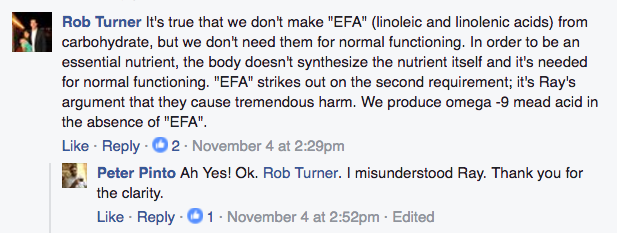Just a quick note. If I make a mistake in the information I provide in any of our videos, I own them. I did make a mistake in this video and would like to clarify.
When discussing the essentiality of “essential fatty acids,” I said that our bodies can make essential fatty acids omega 3 and 6. I was mistaken. In reading Dr. Ray Peats work discussing essential fatty acids, I noticed he said we were able to synthesize fats when we need them, but he was only talking about omega-9 fatty acids. The other omegas ARE NOT synthesized by the body, although they are still not considered “essential” because it can be argued they are not essential for survival. In fact it could be argued they are extremely damaging and should be avoided.
I had to decide wether to take the video down and adjust it or let it stay up and address the mistake. I choose the latter route because the statement still stands true. Polyunsaturated fatty acids are not essential. They’re just not essential for the reason stated in the video.
 A special thanks goes out to Rob Turner of functionalps.com. Rob is a very smart guy who’s spent years of steadying and helping others. On Facebook, Rob very elegantly identified my mistake and commented on it. With a community like this, people can learn so much! I always appreciate constructive criticism. Be sure to check out Rob’s Blog at his website above. He’s truly a wealth of knowledge!
A special thanks goes out to Rob Turner of functionalps.com. Rob is a very smart guy who’s spent years of steadying and helping others. On Facebook, Rob very elegantly identified my mistake and commented on it. With a community like this, people can learn so much! I always appreciate constructive criticism. Be sure to check out Rob’s Blog at his website above. He’s truly a wealth of knowledge!
Leave your comments and constructive criticism below. Enjoy the video!
 You had a stressful day at work and you just wanted to treat yourself to your favorite flavor of Ben and Jerry’s ice cream. On the drive home you begin the mental debate “should I take that gamble?” You think about the last time you had dairy and rationalize why this time won’t be as bad. That last time was just an fluke. So you take the leap, go to the store, and buy your ice cream. Already starting to regret your decision, you take that first bite. You wait a couple seconds waiting and listening for your stomach to let you know how your night is going to be. After awhile you finish your bowl and you lay on the couch and settle in for a nice night… Then it happens.. your stomach comes alive!. You sit up right away clutching your stomach and your doing the dash down the hall.
You had a stressful day at work and you just wanted to treat yourself to your favorite flavor of Ben and Jerry’s ice cream. On the drive home you begin the mental debate “should I take that gamble?” You think about the last time you had dairy and rationalize why this time won’t be as bad. That last time was just an fluke. So you take the leap, go to the store, and buy your ice cream. Already starting to regret your decision, you take that first bite. You wait a couple seconds waiting and listening for your stomach to let you know how your night is going to be. After awhile you finish your bowl and you lay on the couch and settle in for a nice night… Then it happens.. your stomach comes alive!. You sit up right away clutching your stomach and your doing the dash down the hall. You may find adding dairy into your life will simplify things. A glass of milk with a little added honey contains a sufficient ratio of protein, fat, and sugar to qualify it as a small meal. It’s the easiest meal you’ll ever prepare. Adding a small amount of milk with your meals is a good place to start when attempting to build up your production of lactase. We’re talking 1 or 2 ounces of milk with a complete meal consisting of protein, fat and sugar. For example, I may eat a small piece of steak, a side potato, some melon and a glass of sparkling water. I’ll then just add a couple ounces of milk to chase the meal.
You may find adding dairy into your life will simplify things. A glass of milk with a little added honey contains a sufficient ratio of protein, fat, and sugar to qualify it as a small meal. It’s the easiest meal you’ll ever prepare. Adding a small amount of milk with your meals is a good place to start when attempting to build up your production of lactase. We’re talking 1 or 2 ounces of milk with a complete meal consisting of protein, fat and sugar. For example, I may eat a small piece of steak, a side potato, some melon and a glass of sparkling water. I’ll then just add a couple ounces of milk to chase the meal.